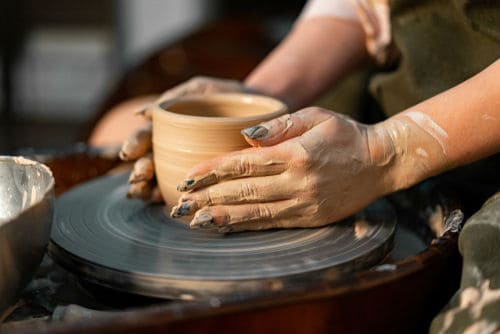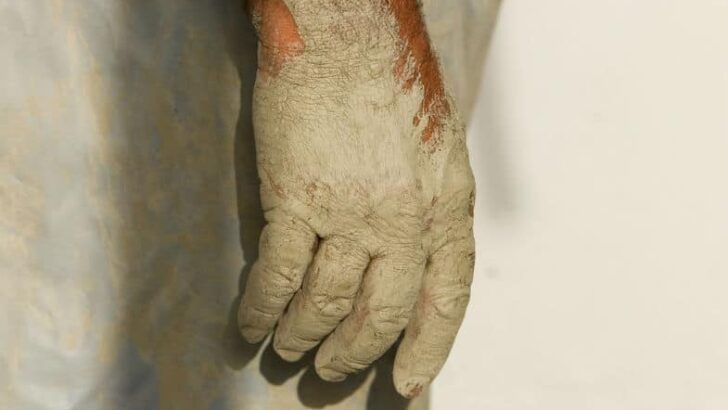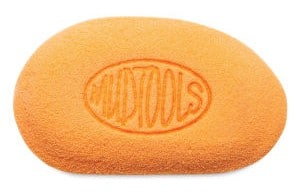There is no way around it, pottery and clay are hard on the hands. The other day as I gave my toddler’s cheek a playful tweak. And I noticed how red and dry my skin was compared to her alabaster face. This is partly due to life wear and tear. But it’s definitely made worse by my hands working with clay. It got me wondering, what can be done about dry hands from pottery clay.
Pottery clay does dry out the skin on your hands and your nails. It’s known in the ceramic world as “potter’s hands”. There are some effective solutions that include adding oil to your throwing water. Warming your throwing water. Using special soaps and moisturizers. Throwing with particular kinds of gloves.
First, I will take a closer look at why pottery clay dries the hands and nails. Then I will describe 10 top ways to give your potter’s hands some much-deserved care.
Disclaimer – Before I continue, I want to point out that I’m not a dermatologist. I’m just a potter whose hands probably look older than they should! I’m sharing these tips with you today for informational purposes as a fellow potter. If you have a skin condition or are worried that you might, you should seek advice from a professional in that field.
What Causes Dry Hands from Potters Clay
- Here are a number of reasons that working with pottery clay is tough on the skin, hands, and nails.
- Clay is wet! Obvious I know, but having your hands in water strips out natural oils from your skin and leaves it dry.
- Some clay is very abrasive. Grogged clay is notoriously tough on the hands. It has the rasping effect of sandpaper and can leave your skin dry and raw.
However, even clay that does not contain coarse grog, is made up of microscopic clay particles. These platelets are hard and have an exfoliating effect. Exfoliation is all very well as a one-off facial in a spa, but not great on your hands day after day. - Even when you wash your hands after pottery, it’s likely that there are some residual clay particles on your skin. These microscopic particles, nestled on your hands will continue to dry your hands after you have finished at the wheel.
- Making pottery is physical and manual. Potters are often quoted as taking a zen approach to pottery and cooperating rather than battling with the clay.
Nevertheless, it is a manual process, and as such, skin and nails are encountering the elements. Any such activity will increase wear and tear on your hands and nails.
So, what can you do about dry hands from pottery clay? Here are 10 top tips to keep your hands and nails looking and feeling peachy.
10 Tips To Prevent Dry Hands From Pottery Clay
Tip 1: Moisturize Before you Throw
Slater on a good layer of your favorite moisturizer before you hit the wheel. Rub in a thick moisturizing barrier cream like Vaseline and wipe off the excess with a paper towel. It will give you a layer of protection.
Tip 2: Put a Little Oil in Your Throwing Water
Add a little oil to the water you are using as you throw. Putting some drops of vegetable oil, olive oil, or baby oil into your throwing water can make a big difference.
Every time you dip your hands in, your hands get a film of protective oil and moisturization. And it doesn’t harm the pottery. Any residual oil will simply burn off when it is fired.
Tip 3: Use Warm Water When you Throw Pottery
I have read on a few occasions that using warm water when you throw is easier on the hands. Honestly, I’m not sure how much of a difference this makes to dry skin. However, I do know that it feels kinder to my hands.
As well as my throwing water I have a bucket next to me to rinse my hands and tools as I go. This is mainly to protect my drains so I’m not washing masses of clay down my sink.
Sometimes if I’m in a rush to get started I will fill my throwing container and bucket with cold water. Using cold water makes my hands feel stiffer and my skin feels more pruney. Not a very scientific observation I know. But it is a simple variable to control. So, I do try to remember to do my hands a favor and use warm water.
If you’re working in a cold studio, you may want to invest in a gadget that keeps your water warm. Many studios don’t have hot water on tap.
You could try using an aquarium heater in your water bowl. This is a flat rubberized gadget that costs about $10.
Or alternatively, you could use a heated dog bowl for your throwing water. It’s a wacky solution, but it works.
Tip 4: Wash Your Hands Regularly
It’s a good idea not to let the clay dry on your hands. Wash your hands regularly throughout the day, and soon after you have finished throwing. Although it may sound obvious, washing your hands well is a must.
Leaving microscopic traces of pottery clay on your hands will continue to dry out your skin when you have finished.
One way of supercharging your handwashing practice after pottery is to add a little salt when you wash. Rubbing gently with salt or sugar will act as an exfoliant to remove the clay particles. Remember to rub gently.
Some potters recommend using a scrubbing brush too. This is good for getting pottery clay out from under the nails.
Tip 5: Using a Good Soap Can Prevent Dry Hands from Pottery Clay
One soap that is often recommended amongst potters is African Black Soap. This soap has antibacterial properties, so it’s good for small abrasions on your hands that have been clay. Clay is after all mud and is a breeding ground for mold and bacteria1.
African black soap is also anti-fungal2. It soothes irritated skin, exfoliates, and moisturizes.
Tip 6: Vinegar – An Antidote to Dry Hands from Pottery Clay
Some potters swear by applying cider vinegar to their hands after working with pottery clay. They recommend washing your hands, and then spraying your skin with vinegar. You then rub the vinegar into your skin, rinse it off, and apply a good layer of moisturizer.
The idea behind this tip is that clay is alkaline, whereas vinegar is relatively acidic. A skin’s natural pH is mildly acidic. By rubbing your hands in vinegar, you are rebalancing the pH of the skin.
Tip 7: Find a Moisturizer that Suits Your Skin
There are some great moisturizers on the market to help with potter’s hands. Ultimately you need to find one that suits your skin. But here are some suggestions that come with high recommendations from potters who regularly have their hands in clay.
The first one I’d like to mention is called Bag Balm. It might sound like a bizarre suggestion because it was originally formulated in 1899 to soothe cow’s udders.
It was designed to promote the healing of small irritations and abrasions on cows being milked.
Legend has it that farmers applying it to cows found it prevented their hands from becoming chapped in the winter. It is used in care packages sent to army troops working in harsh conditions. And it has been used by explorers in extreme conditions such as the North Pole.
However, it is also endorsed by celebrities as being a great moisturizer. And by potters for being a great fix for dry hands from pottery clay.
Whilst we are on a bovine theme, there are a couple of other cow-related products on the market.
They are Udder Balm and Udderly Smooth. Both of these products are endorsed by many potters who find them helpful after a stint on the wheel.
Like Bag Balm, they are designed for soothing cow’s udders, but they are also sold for humans. Because they promote the healing and soothing dry of skin, they are a good option for potters.
Other Non-Cow Related Moisturizers are Available!
Enough with the cows. Some other moisturizers that come with a potter’s recommendation are:
Workman’s Friend: This is non-greasy and fragrance-free and is alleged to have anti-inflammatory properties.
Working Hands: A relatively inexpensive hand cream, that claims to create a protective barrier on your skin.
Aquaphor: is described by the makers as being a healing ointment, suitable for cracked hands, minor cuts, and burns. It is 41% Petrolatum, so it is quite thick. But it doesn’t stay thick or greasy and it has a good reputation amongst potters with dry skin.
Corn Huskers Lotion: This lotion was originally developed for Iowa Farmers, whose hands were exposed to the elements daily. It’s not greasy and absorbs quickly, however, some say the scent is a bit sweet and strong.
Tip 8: Make Your Own Bespoke Moisturizer – Some Simple Recipes
If pottery clay is making your skin dry and you’d rather avoid commercially produced cream, why not make your own? It can be quite straightforward.
Potters love to share recipes for everything from glaze to terra sigillata. The same goes for moisturizers for potter’s hands. Here are a couple of recipes for moisturizers that potters recommend, starting off with the simplest I could find:
Recipe 1
- 80g olive oil
- 20g beeswax
Recipe 2
- Shea butter
- Beeswax
- Coconut oil or butter
- Vitamin E drops
- Essential oils for a nice smell if you are feeling fancy
Tip 9: Sleeping with Moisturizing Gloves On to Heal Dry Hands from Pottery Clay
Another simple idea for looking after potter’s hands is to buy some moisturizing gloves. These are simple, lightweight gloves that you can sleep in.
The idea is that you apply your preferred moisturizer to your hands liberally and then put the gloves on. When you wake up, your hands are like the proverbial baby’s bottom.
Tip 10: Throwing with Gloves on to Prevent Dry Hands from Pottery Clay
A further suggestion put forward by potters is to wear gloves when you are throwing on the wheel. This solution does tend to divide opinion.
Some potters say that wearing gloves makes the process awkward if not impossible. They argue that they rely a lot on the feel of the clay beneath their fingers. As such, gloves make it hard to read the clay and respond well.
However, other potters claim that wearing gloves has been a game-changer for them. Potters with eczema and other skin conditions sometimes find that wearing gloves can help them carry on working with clay. They can also be useful if you have a cut on your hand.
There are many different types of gloves on the market. It’s clearly a matter of preference which ones suit you better if you want to try out this option.
A popular option is to wear hospital gloves that a surgeon or dentist might wear.
Nitrile Gloves, for example. These are tough but thin.
Gloves can be vinyl or latex, depending on your preference. There is a consensus amongst those who wear gloves when making pottery, that they need to be smooth and snug-fitting. This enables you to feel the clay effectively.
Wearing gloves when you throw might not feel like an ideal solution. However, if your hands don’t cope well with clay, it might be a very good option. And, creative people find amazing ways of adapting to difficult physical restrictions.
If you don’t want to go the whole way and wear actual gloves, there are some barrier creams available.
A couple of suggestions are Gloves in a Bottle and Ghost Glove.
Ghost Glove is great for potters because it is designed to protect against dirt and grime.
What About Potter’s Finger Nails?
Pottery is tough on skin and nails. Most potters I know have made a unilateral decision to keep their nails short and sweet. I play the piano too, so frankly, my days of manicured perfection are over. The best I can aim for is keeping my nails short and clean.
However, not everyone is happy to give up on their manicures. Potters often have day jobs and do pottery on the side. Having nice nails, even acrylic nails may be a part of that other work.

As such, the question of whether you can do pottery with acrylic nails may be on your mind. If so, then read on…
Can You Do Pottery with Acrylic Nails?
There is no getting around it, acrylic nails do pose a challenge for a potter. Generally speaking, potters keep their nails short. However, where there is a will there is a way. There are potters who learn to throw with acrylic nails. They find a way of adapting their technique to manage.
Some Suggested Ways to Do Pottery with Acrylic Nails:
If you are going to have acrylic nails, keep them short and round rather than long and pointy. It is easier to adapt your technique if they are short and round. It’s sometimes suggested that they shouldn’t be much passed the end of your fingertips.
Learn to pull your pots using your knuckles on the outside of the pot. Keep your nails away from the pottery surface as much as you can.
Opening the clay is the skill that potters with acrylic nails seem to have the most difficulty with. One suggestion is to use a sponge as a barrier between your nails and the clay. A natural sponge sometimes called an elephant ear sponge will do the trick.
Alternatively, you can try a MudSponge. These are fine-grained, so they won’t leave streaks on your pottery.
And they are highly absorbent, so they will hold water, without dripping excess water on your clay.
Use the sponge when opening the center, or when you have your fingers inside the pot. Press down onto the moist sponge, rather than directly onto the clay. The sponge stops your nails from gouging the clay.
Another option is to wear nitrile gloves. This protects your nails but also protects your pottery somewhat from gouging.
Alternatively, you could try learning to throw by wearing silicone finger protectors. This will undoubtedly feel odd when you first start.
But most things become normal once you are used to them.
And if your acrylic nails are important to you, this might work for you when you are doing pottery.
Check out this video of a potter, throwing for the first time whilst wearing acrylic nails. Her conclusion seems to be that whilst it feels different, it is not impossible, and will just require adjustment.
Final Thoughts
If you are working regularly with clay, having dry hands from pottery clay may feel inevitable and unavoidable. But I don’t think that’s altogether true. Potters spend a lot of time making objects look beautiful. A potter’s hands do amazing things. I think they deserve a bit of a reward for the work they do and the beautiful objects they make.
References:
- https://lass.southtexascollege.edu/art/safety/ceramics.html
- Samaila AB, Yarma AA and Oshomoh EO. Anti-fungal and Anti-bacterial activities of Sabulun salo local soap in Bauchi Metropolis, Bauchi State, Nigeria. Special Fungal Pathogens Journal (SFPJ), Vol 1, No 1, pg: 0014-0018












